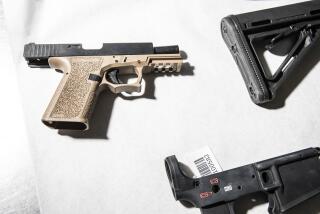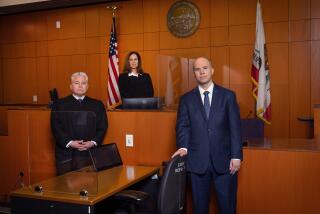State Panel Puts Partial Ban on Court Cameras
- Share via
CHICO, Calif — The state Judicial Council on Friday rejected a broad ban on courtroom cameras but approved a new rule that forbids the broadcast or photography of jury selection, sidebar conferences, spectators or whispering at counsel tables.
Judges also will be required to take into account a litany of considerations in deciding whether to admit broadcasters or still photographers to a trial. These include the security and dignity of the court, the importance of promoting public access to the judicial system, the privacy rights of participants and the potential impact on the jury.
Media representatives and some members of the Judicial Council said the requirement would result in fewer proceedings being televised.
The restrictions, which take effect in January, are the first changes in the judicial system to stem from the O.J. Simpson trial. Passed on a 13-6 vote of the council, the rule is less sweeping than the blanket ban on cameras sought by Gov. Pete Wilson following the Simpson verdict.
The council, the policymaking arm of California’s courts, rejected a wider prohibition on broadcast coverage of trials after some members pleaded for restraint and against an overreaction to the Simpson case.
“I do believe there is an important educational aspect” to broadcasting court proceedings, said Court of Appeal Justice Arthur Scotland, who offered the rule the council adopted and argued that a blanket ban on coverage would defy the council’s long-standing policy of protecting judicial discretion.
Media representatives expressed relief that the council discarded proposed wider restrictions, but complained that the new rule still will reduce broadcast coverage of court proceedings.
“What we got today was a small slap on the wrist as opposed to being put in handcuffs,” said Stan Statham, executive director of the California Broadcasters Assn.
Separately, the Judicial Council shelved a proposal to support non-unanimous jury verdicts in most criminal cases, another idea inspired by the controversy over the Simpson not-guilty verdict. By a voice vote, council members decided to take no position on the proposal and deferred action until later this summer on dozens of other recommendations to revamp the jury system.
Statham complained that the list of issues to consider before allowing cameras will give judges “excuses” for rejecting camera coverage. Scotland, who sits in Sacramento, agreed that judges may be hard-pressed to permit cameras in certain situations and still abide by the new guidelines.
“As long as you have the guidelines,” said Scotland, “you probably aren’t ever going to allow coverage of a bail hearing.”
Under the current system, judges have almost unbridled authority to permit cameras. If the new rule had been in effect during the Simpson trial, the public would have seen a significantly different courtroom.
Television viewers would not have glimpsed the family members of Nicole Brown Simpson and Ronald Goldman reacting to the evidence, sometimes in tears, or the whispering between Simpson and his lawyers or the endless sidebars before Judge Lance A. Ito.
The new rule specifically bars camera coverage of proceedings in chambers and those closed to the public, which already is prohibited, and adds a ban on conferences between an attorney and a client, witness, aide or other attorney and sidebar conferences at the bench between the judge and lawyers.
Reporters also will have to obtain permission from a judge before using a tape recorder, a practice that currently requires no authorization in state courts. Newspapers and broadcasters are supposed to apply for camera coverage five days before a proceeding, but the time requirement will be dropped in hardship cases.
Judges ruling on a media request will not be required to put their decision in writing or to explain it. The new rule applies to both criminal and civil proceedings.
But the rule pleased media representatives substantially more than a task force’s recommendation to ban cameras at all criminal pretrial proceedings and trial sessions not observed by the jury.
“We’re very pleased . . . “ said Gene Erbin, a lawyer representing ABC, NBC, CBS and CNN. “I think they got it right. How many times have you seen a Judicial Council divided like this?”
Council members who favored the wider ban complained that trial judges will feel bound to allow cameras if they were admitted in pretrial proceedings. They also contended that photographing or televising arraignments and bail hearings could unfairly prejudice the public against the defendant, who is often seen in chains and dressed in prison clothing at these proceedings.
A majority of California judges surveyed wanted to ban cameras altogether, and judges since the Simpson trial have barred cameras from some highly publicized cases, including the second murder trial of the Menendez brothers in Los Angeles and the current trial of the confessed abductor and killer of Polly Klaas.
Although Wilson called for denying camera access to all criminal trials, public support for that position did not appear strong. Atty. Gen. Dan Lungren, former Gov. George Deukmejian and former Atty. Gen. John K. Van De Kamp all supported giving the news media the opportunity to persuade judges to permit cameras.
The state Assembly voted overwhelmingly last month to continue the present rule on cameras, but Wilson is expected to veto any such legislation that passes. The California Judges Assn. voted narrowly to recommend uniform guidelines for judges, instead of an outright prohibition, and leaders of the State Bar of California also endorsed giving judges the authority to decide coverage issues.
Court of Appeal Justice Richard Huffman, who headed the task force that recommended wider restrictions, said he was pleased that the council “advanced the system.”
The new rule will ensure “a more consistent set of decisions” by judges on applications for cameras, he said. “Will there be some closures? Yes,” Huffman said. But he added that judges probably will become more receptive to cameras as memories of the Simpson trial fade.
Daniel Kolkey, Wilson’s legal affairs secretary, said the governor was pleased that at least some action was taken to curb cameras.
“While the governor would have preferred a ban on televising and broadcasting criminal trials,” Kolkey said, “we are gratified the Judicial Council has adopted a rule that incorporates, as guidelines, the governor’s concerns. . . . Properly applied, the rule ought to limit the type of television coverage which undermines the defendant’s and public’s right to a fair trial and impairs the dignity of the court.”
Thirty-eight states permit camera coverage of criminal cases and 40 states allow cameras in civil cases. However, several of those prohibit cameras in certain portions of the trial.
The Judicial Council, headed by California Chief Justice Ronald M. George, consists primarily of lawyers and judges. The panel is headquartered in San Francisco but met in the Sacramento Valley as part of an effort to reach out to other parts of the state.
More to Read
Get the L.A. Times Politics newsletter
Deeply reported insights into legislation, politics and policy from Sacramento, Washington and beyond. In your inbox twice per week.
You may occasionally receive promotional content from the Los Angeles Times.











